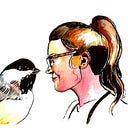How to Find A Four-Leaf Clover
I know all the secrets, and I am ready to share.
Hello, my name is Sophie, and I am truly incredible at finding four-leaf clovers.
Here is some proof:
I have more photos like this available upon request, but I do hope this proves it for you. I’m writing this post now because I found the first four-leaf clover of the season two weeks ago, and since then have found three more. It has begun.
Maybe you are also gifted at four-leaf clover finding, and you’ve clicked on this post in order to seek camaraderie. I get it: it can be so lonely to be special. Just ask the X-Men! If you’re a lonely clover finder, I have good news for you: there are lots of us out there! In fact, the vast majority of people fit into one of two categories: people who have found LOTS of four-leaf clovers, and people who have never found any and are not positive that they exist. And then there are exactly twelve individuals who have found only one in their whole lives. As you can see, that third category is rarer than four-leaf clovers themselves.
Which, by the way, is not that rare. Four leaves occur one time in roughly 10,000 clovers. There are a LOT of clovers in the world. In fact, there are probably way more than 10,000 just outside your window right now. So look: your chances are better than you might think.
But in truth, finding a four-leaf clover is really about knowing what to look for. Here are the secrets that I’ve accumulated throughout the years.
- When looking at a patch of clover, keep your eyes in the middle of the individual clovers.
- A four-leaf clover is easy to spot. Anything you think might be one is not one. A four-leaf clover is definitely a four-leaf clover. So move your eyes quickly and cover a lot of ground; don’t get hung up on the could-have-beens. You shouldn’t need to touch the grass to find a four-leaf clover.
- A lot of four-leaf clovers are taller than three-leaf clovers (since they’re mutations that grow more than a regular clover), so scan the top of the patch of clover.
- If you’ve found one four-leaf clover, there is likely another one nearby. The gene that causes four leaves is inherited, so they tend to grow in packs. Look for number two in the same patch.
- May is a universally good month to look for four-leaf clovers, but I’ve found them as late as October in Chicago, and year-round in New Orleans.
- Believe that you can and will find one. Optimism is the friend of the clover hunter.
Could I leave my house right now and definitely, certainly find a four-leaf clover? I could. That sounds hubristic, but I happen to know that it is true. I have been doing this for a long time, my friends, and I’ve earned myself a little hubris.
Since I have found — let’s face it — thousands if not hundreds of thousands of four-leaf clovers, I also know what you should do with them if you find them.
- Don’t wait too long to press them between the pages of a heavy book. They don’t keep well in pockets, or even held between two fingers.
- During the season, it’s wise to keep two business cards in your wallet that you can press any found four-leaf clovers between. Press the clover, slip the two business cards back into your wallet, and go on walking for ten miles, if you want to.
- If you pick a long enough stem, you can put your four-leaf clover in the tiniest bottle of water for a deeply understated “floral arrangement.” (Pairs well with a single clover flower.)
- If you’re going to get into this and find a whole lot of these, designate a heavy book for all your clovers so you’ll always know where to find them. In high school, I used the dictionary, and pressed them on the pages that contained the words “luck,” “clover,” and “leprechaun.” Today I press them inside a fat book of fancy chickens.
- Or, if you’re feeling whimsical, press them inside as many books as you can! Make them books you want to read or re-read, so that Future You can happen upon the clover and get some good luck.
- Once the clovers are dried, you can tape them on the backs of index cards (use packing tape; it will work like lamination) and write a message of good luck to a friend, and then put them in the mail.
- If you wash the clover thoroughly, you can eat the clover. You could bake into the top of a cookie. There’s something kind of extraordinary about eating a magical item.
- If you’re on a walk, you can give the clover to a kid or a person who looks like maybe they’re having a hard day. You can say, “Hey, I don’t know you, but here’s a little luck I found. I want you to have it.”
